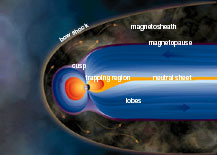This is an artist's depiction of the Earth's magnetosphere.
Click on image for full size
Courtesy of NASA
NASA Will IMAGE the Magnetosphere
News story originally written on March 20, 2000
NASA will launch its newest satellite on March 25th. The Imager for
Magnetopause-to-Aurora Global Exploration (IMAGE) will spend two years studying Earth's magnetosphere. IMAGE will be the first spacecraft to actually "see" the charged particles that make up the field surrounding Earth.
"IMAGE brings to space weather studies the kind of capability
that geosynchronous weather satellites have brought to surface
meteorology," said Dr. Thomas Moore, IMAGE Project Scientist at
NASA's Goddard Space Flight Center, Greenbelt, MD. "We may soon be
treated to evening news images of plasma clouds engulfing those
weather satellites."
IMAGE will have six instruments onboard that will work together to photograph the particles. Scientists say the photos will be combined to create movies. Scientists say this mission is very important to space weather, because the magnetosphere is directly affected by the solar wind.
IMAGE is one of the Explorer Missions NASA has chosen. The project is estimated to cost a total of $154 million -- cheap compared to many space missions.
You might also be interested in:

The Earth has a magnetic field with north and south poles. The magnetic field of the Earth is enclosed in a region surrounding the Earth called the magnetosphere. As the Earth rotates, its hot core generates
...more
NASA successfully launched the Imager for Magnetopause-to-Aurora Global Exploration (IMAGE) spacecraft on March 25, 2000. It took almost an hour to get the satellite into orbit around the Earth. So far,
...more
It was another exciting and frustrating year for the space science program. It seemed that every step forward led to one backwards. Either way, NASA led the way to a great century of discovery. Unfortunately,
...more
The Space Shuttle Discovery lifted off from Kennedy Space Center at 2:19 p.m. EST, October 29th. The sky was clear and the weather was great as Discovery took 8 1/2 minutes to reach orbit for the Unitied
...more
A moon was discovered orbiting the asteroid, Eugenia. This is only the second time in history that a satellite has been seen circling an asteroid. A special mirror allowed scientists to find the moon
...more
Will Russia ever put the service module for the International Space Station in space? NASA officials are demanding an answer from the Russian government. The necessary service module is currently waiting
...more
During a period of about two days in early May, 1998, the ACE spacecraft was immersed in plasma associated with a coronal mass ejection (CME). The SWICS instrument on ACE, which determines unambiguously
...more














